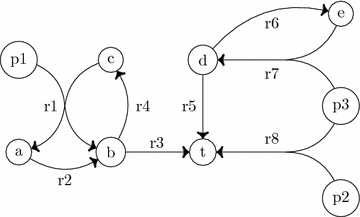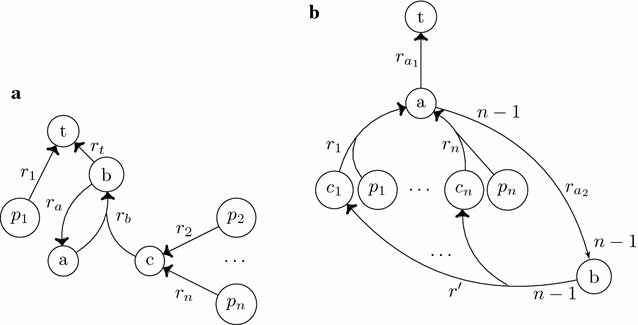Enumeration of minimal stoichiometric precursor sets in metabolic networks
- PMID: 27679654
- PMCID: PMC5029113
- DOI: 10.1186/s13015-016-0087-3
Enumeration of minimal stoichiometric precursor sets in metabolic networks
Abstract
Background: What an organism needs at least from its environment to produce a set of metabolites, e.g. target(s) of interest and/or biomass, has been called a minimal precursor set. Early approaches to enumerate all minimal precursor sets took into account only the topology of the metabolic network (topological precursor sets). Due to cycles and the stoichiometric values of the reactions, it is often not possible to produce the target(s) from a topological precursor set in the sense that there is no feasible flux. Although considering the stoichiometry makes the problem harder, it enables to obtain biologically reasonable precursor sets that we call stoichiometric. Recently a method to enumerate all minimal stoichiometric precursor sets was proposed in the literature. The relationship between topological and stoichiometric precursor sets had however not yet been studied.
Results: Such relationship between topological and stoichiometric precursor sets is highlighted. We also present two algorithms that enumerate all minimal stoichiometric precursor sets. The first one is of theoretical interest only and is based on the above mentioned relationship. The second approach solves a series of mixed integer linear programming problems. We compared the computed minimal precursor sets to experimentally obtained growth media of several Escherichia coli strains using genome-scale metabolic networks.
Conclusions: The results show that the second approach efficiently enumerates minimal precursor sets taking stoichiometry into account, and allows for broad in silico studies of strains or species interactions that may help to understand e.g. pathotype and niche-specific metabolic capabilities. sasita is written in Java, uses cplex as LP solver and can be downloaded together with all networks and input files used in this paper at http://www.sasita.gforge.inria.fr.
Keywords: Metabolic network; Minimal precursor sets; Mixed integer linear programming.
Figures



Similar articles
-
Algorithms and complexity of enumerating minimal precursor sets in genome-wide metabolic networks.Bioinformatics. 2012 Oct 1;28(19):2474-83. doi: 10.1093/bioinformatics/bts423. Epub 2012 Jul 10. Bioinformatics. 2012. PMID: 22782547
-
A mixed-integer linear programming approach to the reduction of genome-scale metabolic networks.BMC Bioinformatics. 2017 Jan 3;18(1):2. doi: 10.1186/s12859-016-1412-z. BMC Bioinformatics. 2017. PMID: 28049424 Free PMC article.
-
Speeding up the core algorithm for the dual calculation of minimal cut sets in large metabolic networks.BMC Bioinformatics. 2020 Nov 9;21(1):510. doi: 10.1186/s12859-020-03837-3. BMC Bioinformatics. 2020. PMID: 33167871 Free PMC article.
-
Basic concepts and principles of stoichiometric modeling of metabolic networks.Biotechnol J. 2013 Sep;8(9):997-1008. doi: 10.1002/biot.201200291. Epub 2013 Jul 29. Biotechnol J. 2013. PMID: 23893965 Free PMC article. Review.
-
Detecting structural invariants in biological reaction networks.Methods Mol Biol. 2012;804:377-407. doi: 10.1007/978-1-61779-361-5_20. Methods Mol Biol. 2012. PMID: 22144164 Review.
Cited by
-
Computing optimal factories in metabolic networks with negative regulation.Bioinformatics. 2022 Jun 24;38(Suppl 1):i369-i377. doi: 10.1093/bioinformatics/btac231. Bioinformatics. 2022. PMID: 35758789 Free PMC article.
-
Heuristic shortest hyperpaths in cell signaling hypergraphs.Algorithms Mol Biol. 2022 May 26;17(1):12. doi: 10.1186/s13015-022-00217-9. Algorithms Mol Biol. 2022. PMID: 35619179 Free PMC article.
-
Metabolic network percolation quantifies biosynthetic capabilities across the human oral microbiome.Elife. 2019 Jun 13;8:e39733. doi: 10.7554/eLife.39733. Elife. 2019. PMID: 31194675 Free PMC article.
-
Seed2LP: seed inference in metabolic networks for reverse ecology applications.Bioinformatics. 2025 Mar 29;41(4):btaf140. doi: 10.1093/bioinformatics/btaf140. Bioinformatics. 2025. PMID: 40163742 Free PMC article.
-
Analysis of Piscirickettsia salmonis Metabolism Using Genome-Scale Reconstruction, Modeling, and Testing.Front Microbiol. 2017 Dec 11;8:2462. doi: 10.3389/fmicb.2017.02462. eCollection 2017. Front Microbiol. 2017. PMID: 29321769 Free PMC article.
References
-
- Romero P, Karp P. Nutrition-related analysis of pathway/genome databases. In: Pacific symposium on biocomputing’01. 2001. p. 470–82. - PubMed
-
- Cottret L, Milreu PV, Acuna V, Marchetti-Spaccamela A, Martinez FV, Sagot MF, Stougie L. Enumerating precursor sets of target metabolites in a metabolic network. In: Lecture notes in bioinformatics, vol 5251. 2007. p. 233–44.
LinkOut - more resources
Full Text Sources
Other Literature Sources
Miscellaneous

